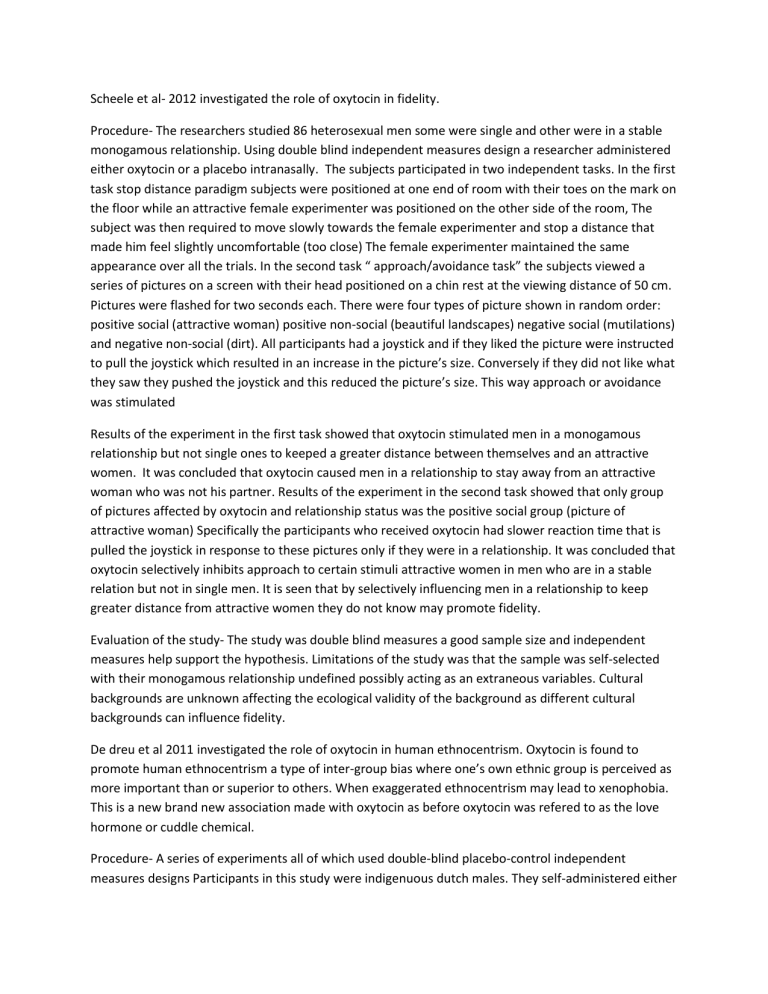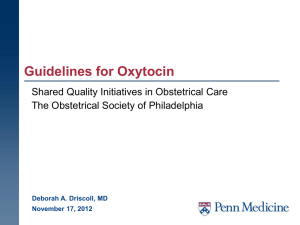
Scheele et al- 2012 investigated the role of oxytocin in fidelity. Procedure- The researchers studied 86 heterosexual men some were single and other were in a stable monogamous relationship. Using double blind independent measures design a researcher administered either oxytocin or a placebo intranasally. The subjects participated in two independent tasks. In the first task stop distance paradigm subjects were positioned at one end of room with their toes on the mark on the floor while an attractive female experimenter was positioned on the other side of the room, The subject was then required to move slowly towards the female experimenter and stop a distance that made him feel slightly uncomfortable (too close) The female experimenter maintained the same appearance over all the trials. In the second task “ approach/avoidance task” the subjects viewed a series of pictures on a screen with their head positioned on a chin rest at the viewing distance of 50 cm. Pictures were flashed for two seconds each. There were four types of picture shown in random order: positive social (attractive woman) positive non-social (beautiful landscapes) negative social (mutilations) and negative non-social (dirt). All participants had a joystick and if they liked the picture were instructed to pull the joystick which resulted in an increase in the picture’s size. Conversely if they did not like what they saw they pushed the joystick and this reduced the picture’s size. This way approach or avoidance was stimulated Results of the experiment in the first task showed that oxytocin stimulated men in a monogamous relationship but not single ones to keeped a greater distance between themselves and an attractive women. It was concluded that oxytocin caused men in a relationship to stay away from an attractive woman who was not his partner. Results of the experiment in the second task showed that only group of pictures affected by oxytocin and relationship status was the positive social group (picture of attractive woman) Specifically the participants who received oxytocin had slower reaction time that is pulled the joystick in response to these pictures only if they were in a relationship. It was concluded that oxytocin selectively inhibits approach to certain stimuli attractive women in men who are in a stable relation but not in single men. It is seen that by selectively influencing men in a relationship to keep greater distance from attractive women they do not know may promote fidelity. Evaluation of the study- The study was double blind measures a good sample size and independent measures help support the hypothesis. Limitations of the study was that the sample was self-selected with their monogamous relationship undefined possibly acting as an extraneous variables. Cultural backgrounds are unknown affecting the ecological validity of the background as different cultural backgrounds can influence fidelity. De dreu et al 2011 investigated the role of oxytocin in human ethnocentrism. Oxytocin is found to promote human ethnocentrism a type of inter-group bias where one’s own ethnic group is perceived as more important than or superior to others. When exaggerated ethnocentrism may lead to xenophobia. This is a new brand new association made with oxytocin as before oxytocin was refered to as the love hormone or cuddle chemical. Procedure- A series of experiments all of which used double-blind placebo-control independent measures designs Participants in this study were indigenuous dutch males. They self-administered either oxytocin or a placebo intra-nasally. Experiments involved exposing subjects to images of people belonging either to their ingroup males or outgroup immigrants from the middle east and german citizens. Experiments used moral choice dilemma tasks such as the famous trolley problem. Participants in the oxytocin and placebo groups were given a series of moral choice dilemmas where decision had to be made as to whether one person should be killed to save five other people. In some of these tasks the target person (the person who will be killed) was a member of the participants ingroup and In other tasks a member of their outgroup. This was achieved by manipulating the name of the target person either a typically dutch name or a typically arab name. The other five individuals were unnamed so their ethnic background was not indicated. The question was in a task like this would a dutch prefer to sacrifice a non-dutch person and how does this depend on oxytocin The results indicated that under oxytocin males were more likely to sacrifice an outgroup target than an ingroup target while under the placebo there was no significant difference. There are two alternative explanations for this finding. Oxytocin promotes ingroup favouristm or outgroup derogation. Further analysis of the data revealed that compared with males in the placebo condition males under oxytocin were less likely to sacrifice a member of their ingroup but were not more likely to sacrifice a member of the outgroup. Conclusion oxytocin creates inter-group bias by increasing ingroup favouritism. Evaluation of the study- Strengths the study had double blind measures, Self-administered, Homogenous group . Limitations- The study was based on the assumption that names can be associated with specific cultures and that the men were aware of these stereotypical names.





